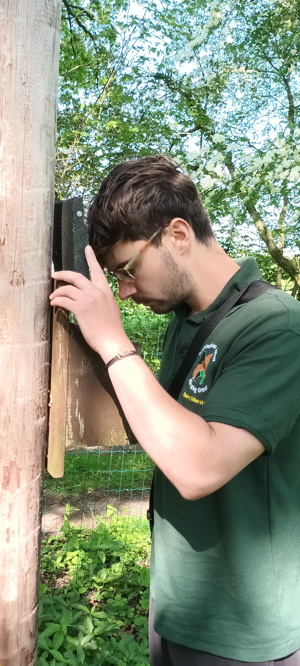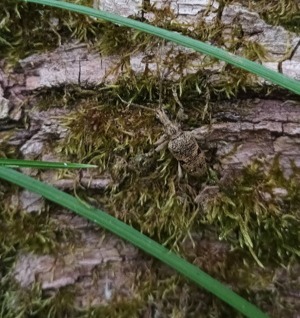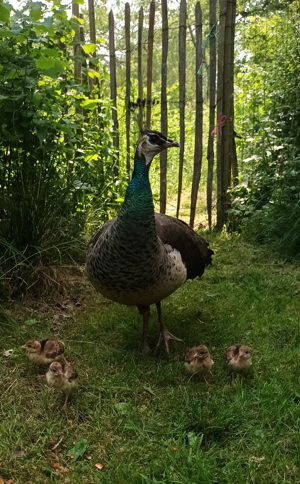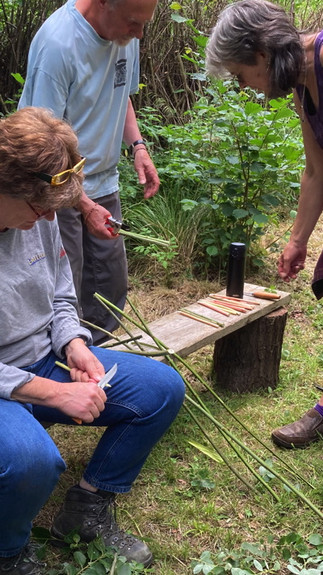
Carolyn Church
Carolyn continues her picture diary from the coppiced hazel woodland in Rockingham Forest. In her previous blog articles you can read about the rigours of woodland life in winter and also the coming of spring
22nd May 2023
The Rockingham Forest Ringing Group have a number of bird nesting boxes in the wood, which are monitored during the late spring and early summer. The Group record the species and number of chicks in the boxes, placing numbered rings on the chick's legs this information is then sent to the BTO (British Trust for Ornithology), so that they can monitor the birds' movements and ages.
Barney is training with the group to gain his ringing licence.

This has been a bumper year for caterpillars, especially that of the Green Oak Tortrix moth, and black dot's of caterpillar poo have been pattering down through the trees like rain, all through the day and night as the hungry caterpillars munch on the Oak leaves in the canopy.
A number of bird species, including Blue and Great Tits time the hatching of their young to coincide with this abundance of food. Imagine being confronted by this ravenous brood of Blue Tits when returning to your nest with a caterpillar.

30th May 2023
These cut logs are going to an Infant school in Kettering.
Here they are pictured in situ where they help to create an outdoor reading and story-telling area.

25th May 2023
We found a Black-spotted Longhorn Beetle. This beetle is found throughout Europe and its larvae develop in Hazel. The second picture shows how well it is camouflaged when crawling over some Oak logs.

6th June 2023.
During the spring we had some Ash trees felled in the back area of the wood, now that the ground has dried out sufficiently we can start extracting the timber without causing compaction of the ground. The smaller branch wood is carried to the ride edge and loaded onto the tractor trailer to be taken to the processing area.
We use a Palax firewood processor to convert the logs into suitable sizes for the charcoal kiln. The machine saws and splits the timber, then the conveyor belt loads the wood into the trailer.
In each charcoal burn we use a mixture of Hazel, Ash and Oak, each species having a slightly different quality, Hazel charcoal burns hot but quickly, Ash less hot but burns slower and therefore lasts longer and the Oak has a pleasant aroma. This mixture gives a good all round burn for barbecuing.
14th June 2023
The Peachicks have hatched... Sweet peas!!
17th June 2023 One of our other jobs at this time of year is strimming pathways through a number of coppice coupes in preparation for guided walks.

24th June 2023
Today was the first charcoal-making course that we have run for Rockingham Forest Vision.
We started with introductions and briefly ran through the itinerary for the day. Then it was on to loading the kiln.

The first step was laying out the bottom of the kiln, there are four inlet channels, one of which I'm standing on. These take air into the centre of the kiln during the burn. There are also four covered outlets that draw the smoke to the chimneys which are positioned on the outside of the kiln.
The kiln is lit from the bottom through one of the inlet channels, so we prepared a fire site in the centre using "brown ends", partially charred pieces of wood from a previous burn. Then we carefully loaded the wood into the kiln cris-crossing the layers as we went, smaller diameter pieces at the bottom and larger logs nearer the top.
We also cut some Willow stems to make into drawing charcoal, cutting them into pencil sized lengths and peeling off the bark. These were placed into a metal container to protect them from damage during the burn. The cylinder was then placed in the kiln.

Here are all of the course participants, viewing the loaded kiln, apart from Sophie who has been taking the photographs, thanks Sophie.
After a well earned lunch it was time to light the kiln. This is done by soaking a piece of cloth in diesel oil, and using a long stick to push the lit cloth into the center of the kiln via one of the inlet channels to the prepared fire site.
At this stage the lid of the kiln is raised slightly and the chimneys are warming on top. It's quite smokey at this point whilst the fire inside the kiln develops. It takes about an hour for the kiln to get up to temperature, and before the smoke begins to leap from the gap around the edge of the lid.
The temperature inside the kiln has to reach 375°C before the wood will start the process of converting to charcoal. Now the lid can be lowered and sealed in place and the chimneys dropped into position. The kiln will now burn for around twenty four hours.

25th June 2023
Towards the end of the burn the smoke coming out of the chimneys is very thin and has a blueish tinge. It also smells more like a charcoal barbecue than wood smoke.

As an aside, we found a lesser stag beetle at the bottom of the wood pile that we had been loading Into the kiln.
To put out the kiln we remove the chimneys, clearing any tar build up from the exit ports. Finally sealing with sand all of the inlets and exits so that no air can enter the kiln and the fire is slowly extinguished. The kiln is then left
to cool for at least 48 hours.
1st July 2023
Even after thirty years of making charcoal there's still a sense of anticipation when opening the kiln after a burn, you never quite know what you're going to find. This looks like a reasonable burn.

The charcoal is shovelled out of the kiln onto the riddle where its graded, large lumps are broken up and the ash and tiny pieces fall through the mesh. Brown ends the partially charred pieces of wood are sorted out to go back into the kiln in the next burn. The remaining charcoal is then bagged up and weighed. This burn produced 61 bags of barbecue charcoal and 8 bags of fines, the smaller pieces that are used by blacksmiths and other specialists.
Here's the drawing charcoal that was also made.

5th July 2023
During the winter the top of a large Elm tree blew down into the pond. As the pond is ephemeral we have waited until now, when it has dried up, to do the clearing. There was a huge amount of Ivy growing around the trunk and branches. Working with Sam Newcombe, who came to us for a day on work experience, we got stuck into clearing the Ivy. We are leaving the tree to slowly decompose, whilst also creating a habitat for aquatic creatures.

14th July 2023
Fungi growing on the fallen elm log just a few days after clearing the Ivy. I think they might be oyster mushrooms.

25th July 2023
I was really pleased with myself today, I managed to replace the spring that triggers the ram on the firewood processor, so now we can split logs again. I remembered to take a picture before I started to take bits apart, a useful tip I'd heard somewhere. It's one of those things that being a woman you're never encouraged to attempt doing anything mechanical, so when the ram worked again it was really satisfying.


25th July 2023
This photo is a little bit macabre, it shows two types of beetle feeding on the decaying body of a toad. The beetle on the right of the picture, with the bright orange bands, is a true burying beetle, burying the carcases of small creatures by digging a shaft underneath them and then dragging the body down into the ground. The females lay their eggs close to the interred corpse, which the larvae feed on when they emerge.
The two beetles in the centre of the picture, are Red-breasted Carrion Beetles. They are found mainly in woodland and feed on other insects' larvae, and according to Wikipedia this apparently makes them important in forensic entomology.

28th August 2023
This picture shows a hornets nest built in a hollow at the base of an old coppiced Ash tree. The structure of the nest is very impressive, and is made entirely of paper that the hornets make from wood. The nest appeared to extend much higher into the cavity, but at the point I took this photo I became aware that the buzzing around me was becoming a little more agitated. Although hornets are not usually as aggressive as their reputation suggests, I decided to make a timely retreat.
And so Carolyn's summer came to an end but her picture diary continues here



























































Comments